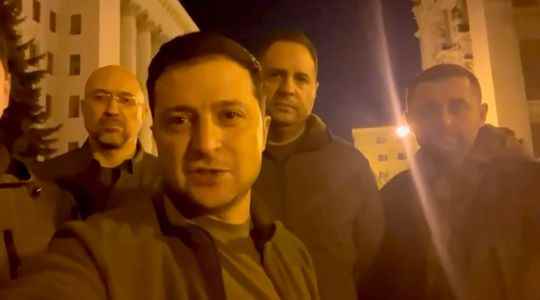On social networks, he is called the “ghost of Kyiv”. According to legend, this mysterious Ukrainian fighter pilot is a hero. On the first day of the Russian invasion, February 24, he reportedly shot down no less than five enemy aircraft. In a few days, Internet users competed in creativity to shape the iconography of this demigod : here a smiling skull surmounted by a plane drawn on an Ace of spades; there a winged creature in the blue and yellow colors of Ukraine, with the effigy of the “Ghost of Kyiv”.
Except that in reality, no one has managed to find the trace of the said pilot. A video showing a military plane shooting down another has been relayed, in particular by the Ukrainian army on Twitter. But these images, which went viral, turned out to be bogus, taken from a hyperrealistic video game.
Whatever, one of the first figures in the communication war between Kiev and Moscow was born. And she galvanized the resistance camp. Just like the fable of Snake Island, these 13 Ukrainian border guards who died as martyrs during a Russian naval strike, after refusing to leave a Ukrainian micro-island in the Black Sea. They had broadcast a video supposed to record their last words (“fuck you!”)… A film relayed by many media and by the Ukrainian president himself. But the soldiers, who were believed to be dead, would in fact be prisoners of the Russian troops.
In the flood of images shared on social networks, propaganda is king, on both sides. And despite their short life expectancy, these contents have their effect. “The goal is not to build an alternative reality, but to maintain a large enough membership so that people maintain a propensity to believe the next stories that will arise, analyzes Alexis Rapin, researcher at the University of Quebec in Montreal. . The first image was so ‘cool’ you buy into the narrative you want to believe.”
In this information battle, Ukraine seems to have taken a step ahead of its adversary. “One of the by-products of this phenomenon is the emergence of a micro-mythology or even a ‘pop culture’ surrounding the conflict” underlines Alexis Rapin on his Twitter account.
Star number 1 of this new pantheon, Volodymyr Zelensky, has become the idol of defenders of Ukraine on the web. The man with the double cap of president and warlord, has all the attributes of the mythological hero, warding off death in the face of the enemy. The 44-year-old former comedian (also known for winning Dancing with the Stars in 2006) does not hesitate to put himself on stage, regularly filming himself in the deserted streets of Kiev.
Moreover, the president has long since built his communication on social networks, as Keliane Martenon, founder of the newsletter “Sur les internets”, reminds us. “If it’s logically become a little institutionalized since his election, he regularly continues the selfie videos in casual clothes”, she explains on her account. But “these videos generate 2 to 3 times more commitment” than more official speeches, notes this former communicator. The strategy, which already paid off before this tragic war, is proving to be extremely effective today.
On the internet, admirers of Zelensky dress up this “Captain Ukraine” with a suit and a superhero shield against the backdrop of a city in flames. The American peplum-style war.
Another variation of the “Zelensky myth”, the videos featuring his speeches against a backdrop of rap hits.
Elsewhere, we play on the religious fiber of Internet users, devoting a cult to an unusual Virgin… embracing, as a child-Jesus, an American Javelin missile, and thanking this “protector of Ukraine”.
In short, there’s something for everyone. This is how the war is (also) fought in 2022: with Internet users who, in the four corners of the planet, use references far from martial declarations and sometimes very out of step with the bloody reality of the fighting. “This communication based on codes of popular culture generates a ‘romanticization’ of the conflict, continues Alexis Rapin. Few Internet users dream of being on the ground, neither on one side nor the other, but in front of their screens , some start to applaud photos of smoking carcasses of tanks, admire the repartee of certain Ukrainian citizens, it almost becomes a spectacle that they follow minute by minute.”
The result is there: a massive mobilization of foreign opinions, especially among the youngest.
Beyond this mythology, very concrete tools are aimed more directly at Russian public opinion. This is the case of this website, developed by the Ukrainian authorities to help the families of missing Russian soldiers to find theirs. Called “200rf.com”in reference to the code name of soldiers killed in action, the platform – banned in Russia – lists the identity documents belonging to men presumed dead since the invasion.
The interest? “Bypass Russian censorship which does not inform families of the fate of their loved ones, so that the Russian population becomes fully aware of the losses and the cost of this war”, explains Jean-Baptiste Jeangene Vilmerdirector of studies at IRSEM, in a recent article.
It is difficult to know how many Russians see these messages and are sensitive to them. This all-out communication from the Ukrainian camp, difficult to control in Moscow, is in any case certainly not to the taste of Vladimir Putin and his entourage. “Reputed masters of the war of narratives, they are ironically their own prisoner, concludes researcher Alexis Rapin: the Kremlin having chosen to hide the nature of the conflict from its population, it can hardly tell anything… since ‘nothing is supposed to happen.”
